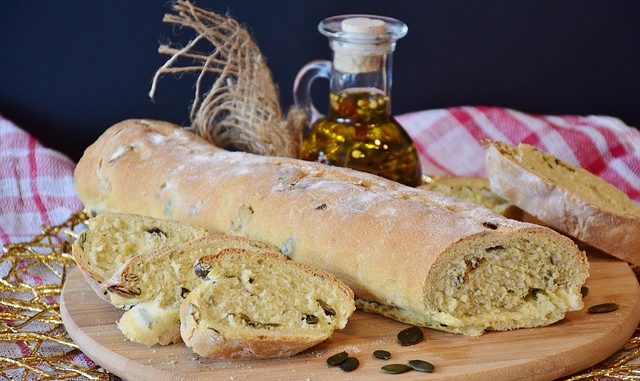
Ciabatta bread, for all its ubiquity has retained its quality even though it is produced a massive scale. It is one of the great breads of the world. I should think every retailer and supermarket must have it at least in their bakery. In Italy, it is still the mainstay of the bakery and rivals only foccacia or focacette. It is an oval, slightly squat and fat loaf which looks like a squashed slipper to some hence its name. Olive oil is used in great quantities which gives the loaf a thin, friable crust. the crumb has holes, but lightness with a slightly chewy texture.
Ciabatta is a great accompaniment to tomato salads and soups because it mops the juices really well. The bread is made using the sponge dough method. The flour, yeast and water are fermented together for 24 hours before being incorporated into the dough. It is not easy to make at home but there are recipes using bread makers which work perfectly well. Obtaining the soft consistency is the tricky part to it. It has a minimum of 75 per cent water and oil which is highly unusual. No other bread contains this type of mix. A very long kneading process contributes to the unique flavour of the bread. It should be sweet and slightly sour with an open crumb texture but crisp crust.
A variety of flavouring are added such as olives, sun-dried tomatoes, cheese and walnuts.
Many loaves are parbaked meaning they must be finished off in the oven at home. The final baking lends flavour and texture. Serve it toasted as it makes a great platter for chicken liver parfait and some onion marmalade.
Recipe For Ciabatta Bread
Preparation time: 20 to 30 minutes to mix but requires an overnight rising
Cooking time: 20 minutes
Ingredients:
- 500g (1 lb, 2oz) strong white bread flour, plus extra for dusting
- 10g (⅓ oz) salt
- 10g (⅓ oz) fast-action dried yeast
- 44oml (14⅓ fl oz) cold water
- fine semolina, for dusting the bread
Preparation:
[a] The biga.
Stir the dried yeast with 50ml warm water, stand for 10 mins, then add another 80ml warm water. Gradually add the flour in a stand mixer on its lowest setting. Once it’s a wet dough, transfer to a well-oiled bowl, cover and leave for 12 hours or overnight at room temperature. It should swell to double and possibly even treble in size.
[b] The Dough
Pre-heat your oven to 220C. Line two baking trays with baking parchment or silicone paper. If using baking paper, dust with lots of the strong flour.
Carefully tip out the dough as it will be much wetter than others onto a hard work surface. No knocking back but handle the dough gently so you keep as much air in it as possible.
Coat the top of the dough with more flour and/or semolina. Cut the dough in half length ways and divide each of those in half length ways also. You should now have four long pieces of dough.


Leave a Reply